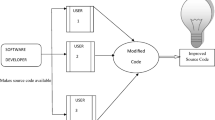Abstract
Software reliability is the important quantifiable attribute in gaining reliability by assessing faults at the time of testing in the software products. Time-based software reliability models used to identify the defects in the product, and it is not suitable for dynamic situations. Instead of time, test effect is used in few explorations through effort function and it is not realistic for infinite testing time. Identifying number of defects is essential in software reliability models, and this research work presents a Pareto distribution (PD) to predict the fault distribution of software under homogenous and nonhomogeneous conditions along with artificial neural network (ANN). This methodology enables the parallel evolution of a product through NN models which exhibit estimated Pareto optimality with respect to multiple error measures. The proposed PD-ANN-based SRGM describes types of failure data and also improves the accuracy of parameter estimation more than existing growth models such as homogeneous poison process and two fuzzy time series-based software reliability models. Experimental evidence is presented for general application and the proposed framework by generating solutions for different product and developer indexes.







Similar content being viewed by others
References
Amara D, Rabai LBA (2017) Towards a new framework of software reliability measurement based on software metrics. Proc Comput Sci 109:725–730
Awad M (2016) Economic allocation of reliability growth testing using Weibull distributions. Reliab Eng Syst Saf 152:273–280
Banerjee I (2017) Advances in model-based testing of GUI-based software. Adv Comput 105:45–78
Byun J-E, Noh H-M, Song J (2017) Reliability growth analysis of k-out-of-N systems using matrix-based system reliability method. Reliab Eng Syst Saf 165:410–421
Dragicevic S, Celar S, Turic M (2017) Bayesian network model for task effort estimation in agile software development. J Syst Softw 127:109–119
Elmishali A, Stern R, Kalech M (2018) An Artificial Intelligence paradigm for troubleshooting software bugs. Eng Appl Artif Intell 69:147–156
Garousi V, Felderer M, Hacaloğlu T (2017) Software test maturity assessment and test process improvement: a multivocal literature review. Inf Softw Technol 85:16–42
Ivanov V, Reznik A, Succi G (2018) Comparing the reliability of software systems: a case study on mobile operating systems. Inf Sci 423:398–411
Kooli M, Kaddachi F, Di Natale G, Bosio A, Torres L (2017) Computing reliability: on the differences between software testing and software fault injection techniques. Microprocess Microsyst 50:102–112
Özakıncı R, Tarhan A (2018) Early software defect prediction: a systematic map and review. J Syst Softw 144:216–239
Rana R, Staron M, Berger C, Hansson J, Meding W (2016) Analyzing defect inflow distribution and applying Bayesian inference method for software defect prediction in large software projects. J Syst Softw 117:229–244
Rizvi SWA, Singh VK, Khan RA (2016) Fuzzy logic based software reliability quantification framework: early stage perspective (FLSRQF). Proc Comput Sci 89:359–368
Sagar BB, Saket RK, Singh G (2016) Exponentiated Weibull distribution approach-based inflection S-shaped software reliability growth model. Ain Shams Eng J 7(3):973–991
Shao Y, Liu B, Wang S, Li G (2018) A novel software defect prediction based on atomic class-association rule mining. Expert Syst Appl 114:237–254
Singh A, Bhatia R, Singhrova A (2018) Taxonomy of machine learning algorithms in software fault prediction using object-oriented metrics. Proc Comput Sci 132:993–1001
Wang J, Zhang C (2018) Software reliability prediction using a deep learning model based on the RNN encoder–decoder. Reliab Eng Syst Saf 170:73–82
Wang J, Zhibo W, Shu Y, Zhang Z (2016) An optimized method for software reliability model based on nonhomogeneous Poisson process. Appl Math Model 40(13–14):6324–6339
Washizaki H (2017) Pitfalls and countermeasures in software quality measurements and evaluations. Adv Comput 107:1–22
Xiao P, Liu B, Wang S (2018) Feedback-based integrated prediction: defect prediction based on feedback from software testing process. J Syst Softw 143:159–171
Yang J, Liu Y, Xie M, Zhao M (2016) Modeling and analysis of reliability of multi-release open source software incorporating both fault detection and correction processes. J Syst Softw 115:102–110
Zhang X-Y, Zheng Z, Cai K-Y (2018) Exploring the usefulness of unlabelled test cases in software fault localization. J Syst Softw 136:278–290
Author information
Authors and Affiliations
Corresponding author
Ethics declarations
Conflict of interest
We don’t have any conflicts of interest.
Research involving human participants and/or animals
No animals and humans are involved.
Informed consent
We use our own content.
Additional information
Communicated by Sahul Smys.
Publisher’s Note
Springer Nature remains neutral with regard to jurisdictional claims in published maps and institutional affiliations.
Rights and permissions
About this article
Cite this article
Sudharson, D., Prabha, D. A novel machine learning approach for software reliability growth modelling with pareto distribution function. Soft Comput 23, 8379–8387 (2019). https://doi.org/10.1007/s00500-019-04047-7
Published:
Issue Date:
DOI: https://doi.org/10.1007/s00500-019-04047-7




